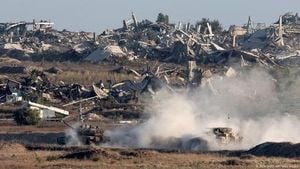Thailand is grappling with one of its worst air pollution crises, sharply affecting public health and wellbeing. Recent reports indicate rising levels of hazardous particulate matter, particularly during the smog season, which spans from December to March. This annual phenomenon sees the Air Quality Index (AQI) frequently surpassing safe limits, making breathable air increasingly rare for city dwellers. The crisis has provoked a torrent of hospitalizations for respiratory issues, leaving many to question how sky-high pollution levels have become the norm.
Dr. Anan Chuenchom, director of the Public Health Department, states, "Air pollution has become more than just a seasonal problem; it has turned chronic for many city dwellers." His remarks encapsulate the extent of the societal and health impacts the crisis has inflicted, with vulnerable groups such as children and the elderly being hit the hardest. Reports show alarming spikes in respiratory illnesses, prompting health officials to issue warnings and advice on preventive measures.
The sources of Thailand's air pollution are manifold, prominently featuring agricultural burning practices, vehicle emissions, and discharges from factories. Locals are all too familiar with the acrid smell of smoke during this time, which has become synonymous with daily life. Villagers resort to wearing face masks outdoors, and there have even been school closures across affected provinces. This has led to many parents expressing concerns about children’s exposure to unhealthy air quality.
Activist Korn Tapir emphasizes, "We need immediate action to inform the public and protect vulnerable groups, particularly children and the elderly." The data underlining the health impacts is alarming; with hospitals reporting increased patient numbers presenting chronic respiratory conditions, the statistics compel urgent action from both the public and private sectors.
Recognizing the rising health crisis, the government has implemented initiatives to mitigate these effects and educate the public on the condition of the air as measured by the AQI. Authorities are also ramping up investment toward public health initiatives aimed at addressing pollution-related ailments and raising awareness around effective prevention techniques.
Educational campaigns targeting at-risk populations serve to mobilize community resources, such as funding for health services and dissemination of information about the dangers of prolonged exposure to polluted air. Officials have been optimizing resources to target pollution hotspots, ensuring the most heavily impacted areas receive the necessary attention.
Despite the set strategies, critics argue more systemic, long-term solutions are necessary to address the root causes of air pollution effectively. Some experts advocate for stricter regulations on emissions from agricultural and industrial sources, citing the pressing need for comprehensive policies and improvements toward public transit systems to reduce vehicular emissions. There is also continued advice for farmers to adopt more sustainable practices and limit burning activities.
With the crisis showing little sign of abatement, it remains to be seen how policy measures and public action will evolve. Nevertheless, as the air quality deteriorates, the call for immediate action rings louder. Experts reiterate the need for collaboration between government and community efforts to teach responsible environmental practices alongside enforcing accountability for polluting activities.
The stakes are high, and the urgency to combat the adverse health impacts of air pollution cannot be overstated. Thailand stands at the cusp of necessary change, with the opportunity to implement sustainable solutions to protect its air quality and the health of its citizens. The time to act is now. If these steps are taken seriously, Thailand can transform the air quality crisis from what seems like an insurmountable challenge to manageable conditions for current and future generations.



